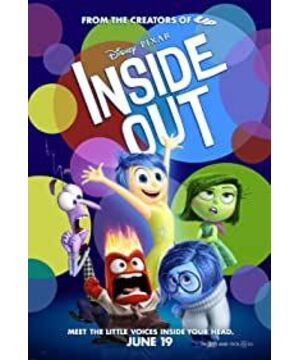Deserved best animation of the year. The playfulness of the film is reflected in the details of the plot development.
It is suitable for downloading and watching the movie, and slowly brushing the details
——————————————————
After watching the whole film, let’s take a look at the details. After watching it, you will understand why this film is so coherent and coherent.
(The names of the protagonists are simplified below—J=JOY, S=SADNESS, BB=BING BONG)
The contradiction in the film focuses on the emotional setting of J and S, just as the adventure of the main line of the film is from the core memory ball of J and S’s dispute Get up.
The first conflict between J and S appeared around 41 minutes into the film.
BB takes J and S to catch the train of thought from the shortcut. And this shortcut "abstract space" is a dangerous place.
There is a detail here, BB interprets danger as a shortcut, obviously he is illiterate. At this time, the value of S is reflected. S has seen this place in the manual. She warned J that this place is dangerous and should be detoured.
However, J's attitude towards S at this time is a firm disapproval.
Things took an unexpected turn just as S feared. In the end, it was S that taught everyone to become a line to escape from the abstract space.
At this time, J did not notice the role of S at all.
The video is about 49 minutes
For the first time, J noticed the role of S.
BB was sad because the rainbow car was pushed into the ruins of memory, J tried all kinds of amusing methods, but failed to restore BB's mood, when S sat next to BB to accompany him to talk, J's initial reaction was "Sadness" , don't make him feel worse."
Yes, BB was moved to cry by S's words, but after crying, he cheered up.
J was surprised, she asked SADNESS: "How did you do that?" S replied: I don't know, I feel sad so I listen to what..." The
answer was interrupted by the exclamation of BB finding the train , and J did not continue to listen.
The film did not specifically express the lost expression of S who was interrupted, but if it was you, you would definitely feel uncomfortable in your heart. What
S did is what J did not do to listen carefully and empathize. Or she gave the BB what the other party wanted at that moment, the so-called empathy.
The film is about 52 minutes.
J, S, and BB got on the train of thought for the return trip. At this time, RILEY fell asleep, and the train of thought stopped (The train of thought stopped running when he fell asleep is a logically consistent detail). At this moment, the train stopped right next to Dream Productions, and S suggested: "How about we wake her up ."
J's first reaction was that S's proposal was ridiculous and impossible, but when she looked in the direction of S's gaze, After seeing the dream productions, she immediately said a line "How about we wake her up." that S has already said (the script uses the exact same line, which is quite interesting).
J was once again indulging in the positive of "We can fix it". At this time, S's answer was "Great idea, JOY." If it was you, what would you think?
The role of S invisibly embodied is not realized by J, just like JOY's always shining one, as if everything can be fixed only in her hands, and the value of the existence of the gloomy S has not been understood by people. It also deepened S's doubts about himself (this clue paved the way for the eagerness to search for S after J escaped from the ruins of memory, but S sees J but immediately escapes the plot sublimation).
About 53 minutes of the film
J and S got into an argument about how to wake up RILEY.
S said "She wake up sometimes when she has a scary dream" JOY then retorted "She's been though enough already." J refused S's proposal on the grounds that she knew RILEY enough, without thinking about it at all, The positive way wakes up RILEY.
In fact, the keyword SCARE also has a foreshadowing in the early stage of the film. It appeared in about 19 minutes. RILEY had a nightmare on the first night when he moved to a new home. In order not to wake RILEY, J interrupted it and played a warm picture. Let RILEY fall asleep in beauty.
Obviously, J didn't realize that SCARE can wake people up from their dreams, and beauty will only make people more indulged in sleep.
S knows this. So S said 'That's never happen before', but at this time J ignored what S said and began to happily arrange the work of each character. When S emphasized again 'I don't think this happy thing is going to work, but if we scare her...', JOY interrupted her bluntly and said 'Just follow my lead'. Until S didn't cooperate J's performance, when J accused her of destroying the dream, when S told J "It's working" with the "awake indicator" meter, J showed a surprised expression again.
This surprised expression represented that J recognized S once again, so when they were about to escape from the clown in the subconscious area, J chose to wake up the clown and wake up RILEY with the SCARE method.
This is the first for J and S We cooperated each time because of the same value orientation, carrying great fear together for the good cooperation of RILEY.
In fear, J said to SADNESS with excitement, "Nothing like a good scare to wake you up, right?" S nodded with a slight smile.
After successfully waking up RILEY, they got on the train of thought again, J said to S "You're not so bad." For the first time, S shows joy because of his worth (see, J and S are unknowingly intertwined in this way).
At this time, the memory ball that parents and teammates encouraged RILEY to appear.
Just when J felt that S also became cheerful, S talked about the unpleasantness of this memory again.
You thought that the differences between J and S were irreconcilable again, but you were wrong. This just paved the way for J to realize the value of S in the ruins of memory later.
The plot wasn't enough. At this time, the Honest Island was destroyed, which also blocked the progress of the thought train. When the family island was about to be destroyed, they discovered the recall tube.
But up to this point, J still refused S to touch the core memory ball. In order to prevent S from staining the memory ball, she chose to enter the recall tube alone, but it was also the time wasted by this dispute, which led to the destruction of the family island where the tube was destroyed. , J fell into the abyss of memory ruins.
J and BB are trapped in the ruins of memory, and J is sad and crying, what an unofficial thing to do.
It's just that the sad tears just fell on the memory ball mentioned earlier.
This also became the key to the turning point of the whole play, and J suddenly realized the value of S: They came to help because of sadness.
This paved the way for the later mixed color memory ball.
At this time, I have to mention that BING BONG gave up himself to help JOY escape from the ruins of memory, which is the most tear-jerking scene in the whole play. Earlier we saw that BING BONG was sad because the rainbow car was pushed into the ruins of memory, but at this time it was precisely because of the rainbow car that had fallen into the ruins that JOY was able to escape the ruins of memory. The foreshadowing of the clues before and after the film is very delicate, and this actually indicates the interweaving conversion of JOY and SADNESS, which is really worth pondering.
Here is one more detail that makes the logic self-consistent. Have you ever wondered why BING BONG will dissipate in the ruins of memory, but JOY will not. Because "Emotions can't quit." This foreshadowed at the 50th minute of the film, when FEAR wanted to quit his job, DISGUST had a foreshadowing to what he said. So JOY will not dissipate even in the ruins of memory.
Then looking back, JOY and SADNESS returned to the headquarter, FEAR and DISGUST both hoped that JOY could fix the situation at that time, but JOY just said very firmly "SADNESS, It's up to you." Facing JOY's behavior, FEAR, DISGUST and ANGER showed surprised and questioning expressions, just like JOY at the beginning.
SADNESS still doubted herself at this time, but JOY had fully realized the value of SADNESS, and her affirmation gave SADNESS confidence. JOY no longer keeps the core memory as her own, she and SADNESS jointly created the first mixed color memory ball. The scene of RILEY embracing his parents echoes the memory ball that both JOY and SADNESS liked, but this time, blue and gold are no longer separate parts, they have become one of you and me, The value of 1+1>2 is realized.
Finally, I have to mention that the English title of the film, INSIDE OUT, is very popular. The emotional villain is INSIDE, and RILEY is the expression of OUT. JOY's initial suspicion of SADNESS's value was INSIDE. Through the development of the plot, JOY finally understood that SADNESS's value is the embodiment of OUT. If growth is one of the inseparable themes of this film, then it is different from other growth-themed films in that it shows two layers of growth: the protagonist RILEY and the emotional villain JOY, which precisely interprets INSIDE subtly The meaning of OUT, the real growth is also from the qualitative change of INSIDE to the manifestation of OUT.
The amazing thing is that such a masterpiece was actually seen for the first time on the flight of Hainan Airlines (the domestic theaters have not yet released it, the film of Hainan Airlines is so new, and the level of love for Hainan Airlines instantly exploded), and I chose this movie. The original intention of watching the film was because I thought that I would just watch a relaxing cartoon for a short time on the plane. I didn't expect to encounter such a good film.
Highly recommend.
View more about Inside Out reviews











